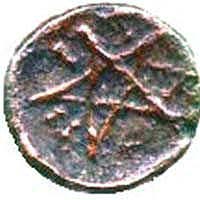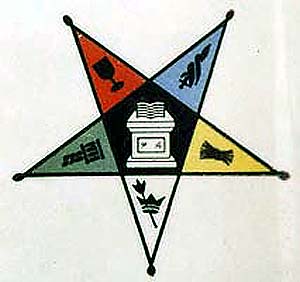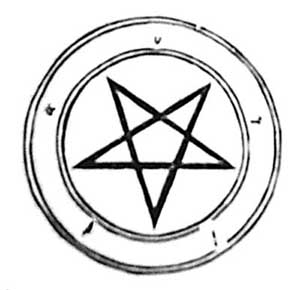The Pythagorean Pentacle - it is Two Points Up
Guardians of Darkness
Comrade August and T. Jantsang
SEE BOOK: "TARTAROS" BY JOHAN AUGUST ALM, MOST COMPREHENSIVE BOOK ON WESTERN DARK TRADITION.
We wish to show, and make perfectly clear, a fact about the pentacle and its history.
That it was used in Greece during antiquity is commonly known and agreed upon. Few, however, make mention of the fact that it was always made with two points up!
What is worse, many of those who know exactly what the Pythagorean Pentagram actually was and is deny it to others and, to make it even worse than worse, when such people are then presented with the visual and ancient proof - they admit it and say that this shouldn't be told to others! Why not?
This star positioning is clearly shown in the Eastern Star used today by Freemasons, some of whom claim their tradition is Pythagorean. This fact was elaborated upon in Western Roots Part One, which explains Pythagoreanism and clearly separates Plato from Socrates and shows the clear distinction between the two of them. That book that has this chapter can be purchased on amazon or Lulu. [NOTE: The BOOK "Tartaros" is 100 times more comprehensive. Tani Jantsang]
People "into" Pythagoreanism today, the worst of them fake teachers of this esoteric system, usually claim the pentacle was one point up with a male image inside the star and claim that the pentacle represented Mars, Venus, Sun, etc. Some of them claim that the symbol only represents the "four elements plus spirit," a magical system that is medieval. They lie. That is a bold-faced lie told out of either complete ignorance or the determined desire to cover up esoteric traditions!
Absolutely nothing supports their claims. The true Pythagorean pentacle was (and is) two points up and was considered a Pentagrammon - a house in the center, a pentagon (pentagonas) representing the Self, and the five points or blazing angles (pentalpha) represented the Pentemychos - inside the angles, and outside of them - every single line has meaning in this Master Glyph and none of it, not one bit of it, was medieval stupidity.
Our statements have support in the coins these ancient people made themselves and in other images that are not modern at all or part of some "modern occult system" out there today. It is also confirmed by Agrippa as will be shown below with an actual image.
Here below are seven different designs of ancient Greek coins with pentagrams on them: every one of them is two points up. There are also many different variations of coins of each design. Photos of seven coin designs are shown below.
One researcher in old coins writes about the coin that is shown first as "Coin One" that: "The extraordinary variety of the types, and the fact that no specimens have been found outside Melos, lead us to suppose that their circulation was mainly local, and that they represent successive issues probably struck on the occasions of recurrent religious festivals, chiefly perhaps connected with the worship of the Phoenician Kabeiri, of the Libyan Ammon (cf. the Rams' heads and the Pentagram, his symbol on coins of Pitane, supra, p. 537), and of Aristaeos (Grapes, corn-grains, stars, etc.); cf. Cyrene, p. 865." - http://www.snible.org/coins/hn/addenda.html
So, the pentagram was also a symbol of the Ammon, which is Pan.
Red lines on the images of coins point to the pentacle where it is not as obvious as it is on other coins.
Coin One
MYSIA, ca 4th Century BC, Head of "Zeus Ammon" / Pentagram. In
some designs the head of Zeus Ammon is replaced with Head of Bacchante or ophamlos
entwined by a serpent.
Coin Two
Thrace, Cherronesos, circa 400-350 BC, AR Hemidrachm. Lion / Pentagram and
VE monogram.
Coin Three
Lucania, Velia, ca 350-400 BC, Didrachm. Head of Athena, helmet shows griffin
ornamentation / Pentagram.
Coin Four
Alexander III, The Great; 336-323 BC, AR Drachm. Head of Herakles, wearing
the skin of the Nemean Lion, which he slew as one of his "12 Labours".
/ Zeus seated left, holding eagle and sceptre; ALEXANDROU (in Greek) to right,
lion's head and the letter Phi (circle with line through) in field to left;
pentagram under throne.
Coin Five
SAMNIUM, Beneventum, 265-240 BC, Æ 20mm. BENVEN-TOD, laureate head
of Apollo / PR-O-P-OM, horse prancing right; pentagram above.
Coin Six
CAMPANIA, Teanum Sidicinum, circa 265-240 BC, Æ Obol. Laureate head
of Apollo left; O (obol) behind / Man-headed bull standing right, being crowned
by Nike who flies above; pentagram below.
Coin Seven
Pentagram on reverse of a small bronze coin (AE10) from Pitane, Mysia, 4th-3rd
cent, BC. Letters around the pentagram spell PITAN (Serpent).

Modern Eastern Star in some Freemasonry

Finally, for the final proof that this knowledge was still around in the 1500s to some extent: Heinrich Cornelius Agrippa von Nettesheim (a theologian, physicisn and legal expert) had a drawing of a two points up pentacle where he informed the reader it is "Pythagorean," in his Occult Philosophy, first published in 1533 AD. He had other drawings, too, of pentacles one point up with a man inside, with astrological symbols. But for the two point up pentacle, he specifically informs us that he knew it was Pythagorean.
This below is a scan of the symbol from the actual 1533 AD edition. The image shows a pentacle inside of two circles. Between the circles, but not at the points of the pentagram, are what Agrippa sees as the five beginning letters of "elements." The letters on the image are not all too clear to see, but starting at the top point and reading them clockwise the letters are "upsilon," "gamma," "iota," "epsilon and iota," and "alpha." The "elemental scheme" was typical of medieval thinkers and even found in some earlier exoteric teachings. However, the letters actually spell UGIEIA (often rendered Hygieia), which means HEALTH (John Burnet, Early Greek Philosophy, 1948, page 295). The Pythagorean pentacle was absolutely a symbol Health seen altogether in all its complex meaning. Agrippa, and others, recognized the letters as being the five beginning letters of the words: udor (water, often transliterated as hydor), ge (earth, Agrippa used gaia), idea (idea as in The Platonic Idea), eile (sometimes written as heile, heat, it meant that in the Greek known to Agrippa), and aer (air). However, note that even if one uses the "elemental" scheme that Agrippa used, it's a definite stretch because it uses heat (heile), which is not an element but a quality OF the element fire. Had Agrippa used the Attic Greek, which is the language Pythagoreans back then actually spoke and wrote, he could have used (phonetic) "empreesis" for fire or conflagration.
The Ugieia, Health, is ancient Pythagoreanism. "The pentagram has always been prominent in magic and apparently owes its position to the Pythagoreans, who called it "Health," and used it as a symbol of recognition of members of the brotherhood. It seems that it owed its properties to the fact that the dodecahedron has pentagons for its faces and is in some sense a symbol of the universe." (TL Heath, A History of Greek Mathematics, Oxford, 1921, Volume 1, pages 159, 162, 294-6. Bertrand Russell, A History of Western Philosophy, 1945, page 147.)
In the image below, the notion of Health that is within and inside a living being, is "bounded between the rings" (kyklos/space and binding force/Demiurge/foundation), and even if seen as the medieval elements, Living Things are the things traveling the Wheel of Life, and not directly connected or part of the Pythagorean pentagram itself, which is at their core in the center, a Core of Inner Being. When one had Health, they were considered Zoös and in their hearts there was Eros (the word did not mean "erotic" in the sense we mean it today at all). To not have Health was to be Thanatos - a word that does not exactly mean dead as in "dead and buried," but means dead inside but alive, like a shell.

![]()
This is an esoteric connection, but note that the Core is the Greek Goddess Kore (another name for Persephone, alongside Hecate queen of the underworld), whose symbol was the apple. If you cut an apple transversally through its core, it reveals a pentagram. The apple is also still, despite Christian ideas over the years, a symbol of health! (An apple a day keeps the doctor away!)
In the play Medea by Euripides, the sorceress Medea calls upon Hecate with the words, "By that dread queen whom I revere before all others and have chosen to share my task, by Hecate who dwells within my inmost chamber, not one of them shall wound my heart and rue it not." Note that she speaks of the Heart. The inmost chamber is the Mychos. Normally, Hecate and Persephone are portrayed as just being the rulers of the Underworld, however, Hecate is called the Lady of Tartaros, Phulada (Guardian), Propulaia (Before the Gates), Kleidophoros (Key-bearer) and Kleidoukhos (Key-holder, Priestess) - but this Underworld of the Greeks and Pythagoreans is also the "inmost chamber" and the Core of Inner Being.
Pentemychos was the title of a work written by Pythagoras' teacher and friend Pherecydes. Pentemychos means five "recesses" or "chambers" also known as the pentagonas - the five-angle. (This is actually a lost book whose contents are preserved in Damascius de principiis, quoted in Kirk and Raven, The Pre-Socratic Philosophers, Cambridge Univ. Press, 1956, page 55). It was also the "place" where the first pre-cosmic offspring had to be put in order for the ordered cosmos to appear. The pentemychos is in Tartaros.
Tartaros was also later seen as the "chthonic realm" where all the enemies of the cosmic order were locked away, also called the "prison-house" of Zeus. It was said to lay outside of the aither over which Zeus had lordship; what we today would call space, back then called "Zeus' defense-wall," yet it was also beneath the earth. Plato (in Cratylus) said that the aither had a penetrating power that permeats the whole world, and he found it both inside and outside of our bodies. Plato was a Pythagorean. The pentemychos is outside, or in-side, of the aither, and hence the pentemychos, too, permeates everything.
However, in very early Greek thought, Tartaros was the first existing Darkness from which the cosmos is born. While it was locked away after the emergence and ordering of the cosmos, it still continued to have an influence. In fact, it was known as "the subduer of both gods and men" (Homer), and it was from this that the world got its "psyche" (soul) and its "daimon." The Boundless Darkness held influence through Mychos or Krater. Apart from being the gateway from "there" to "here" it was also a way in the opposite direction, from "here" to "there", as is evident in the many tales about how Greek heroes, philosophers and mystics descended to Tartaros/Hades (the distinction between the two was very optional back then) in quest for Wisdom. The Underworld as the source of wisdom was the rule. Additional information on pre-cosmic ideas is in information on the Pythagorean APEIRON.
The much older SUMERIAN pentagrams served as pictograms for the word UB; meaning "corner, angle, nook; a small room, cavity, hole; pitfall," suggesting something very similar to the pentemychos. In the Labat (dictionary of Sumerian hieroglyphs/pictograms) it is the number 306, and it is shown as two points up.

Objective information on the pentacle, used as a Baphomet, Goat of Mendes, for the union of Ophites, Pythagoreans and the older Pan or Goddess (Sophia) groups - and as (allegedly?) used by the Knights Templars can be read about in Four Articles on the Baphomet.
Here is information on Pythagoreanism and Tartaros
Detailed information on the Pentemychos system can be found in a monograps, Tantra, Vajrayana and Pythagoreanism, a chapter in a book sold here.
It's not all too clear where the notion of a one-point up star with a man inside it came from, but it might be a Christian confusion or distortion from Angeology or Demonology. It is a confusion or outright lie that has been carried forth to the present day. The popular explanation for such a symbol passes itself off as "white light" type religion - and for some reason the deeper mysteries contained in the glyph that was the actual pentacle, two-points up with the "house" the proper way at the center, is kept secret. Even among those that know about Pythagoreanism and admit it when presented with a few facts, there are some that tend to not want others to find out what any of it means. There are quite a few websites out there pronouncing on the math contained in the pentacle, all showing the pentacle upside-down (that is, one point up!)- but this glyph was much more than just a mathematical symbol.
What this one-point up image would actually stand for in Pythagorean terms/symbolism, is explained in a monograph, a chapter in book, Sigil of Baphomet, sold here.
All in all, three monographs explain this entire system of esoteric knowledge, using words more familiar to occultists, such as Kabalistic words; the chapters on Taoism, Kaballa and Tantra also sold here. All chapters in a book.
NOTE; THE MOST COMPREHENSIVE INFORMATION ON WESTERN DARK TRADITION IS IN "TARTAROS" BY JOHAN AUGUST ALM.